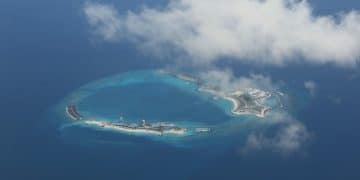NATO’s Future: Assessing Its Role in a Shifting Geopolitical World

The Future of NATO: Assessing the Alliance’s Role in a Changing Geopolitical Landscape involves navigating evolving threats, maintaining transatlantic unity, and adapting to technological advancements to remain a relevant and effective security organization.
The post-Cold War era has seen a significant evolution in the global geopolitical landscape, and with it, the role of the North Atlantic Treaty Organization (NATO). Assessing the Future of NATO: Assessing the Alliance’s Role in a Changing Geopolitical Landscape is crucial for understanding international security and defense strategies in the years to come.
Understanding the Evolution of NATO
Since its inception in 1949, NATO has undergone substantial transformations. Initially formed to counter the Soviet Union, the alliance has adapted to new challenges, including terrorism, cyber warfare, and geopolitical shifts.
NATO’s Cold War Origins
NATO’s primary objective during the Cold War was to provide a collective defense against the Soviet Union. This involved military cooperation, strategic planning, and the deployment of forces across Europe.
Post-Cold War Adaptations
Following the collapse of the Soviet Union, NATO faced the task of redefining its role. This led to initiatives such as the Partnership for Peace program and interventions in the Balkans.

The transformation included:
- Expanding membership to include former Warsaw Pact countries.
- Engaging in peacekeeping operations in the Balkans.
- Addressing new security threats such as terrorism and cyberattacks.
NATO’s evolution reflects its capacity to adjust to changing global circumstances, demonstrating its enduring relevance.
Current Geopolitical Challenges Facing NATO
Today, NATO faces a complex array of challenges that require strategic adaptation. These challenges include the rise of new global powers, regional conflicts, and emerging security threats.
The Resurgence of Russia
Russia’s assertive foreign policy, including its actions in Ukraine and its military modernization efforts, poses a significant challenge to NATO. This has led to increased military deployments and exercises along NATO’s eastern flank.
The Threat of Terrorism
Terrorism remains a persistent threat, with groups like ISIS and al-Qaeda capable of launching attacks in NATO member states. This requires enhanced intelligence sharing, border security, and counter-terrorism operations.
Cyber Warfare and Hybrid Threats
Cyberattacks and hybrid warfare tactics are increasingly used to undermine NATO’s security. This includes disinformation campaigns, election interference, and attacks on critical infrastructure.
Addressing these threats involves:
- Strengthening cyber defenses and enhancing cyber warfare capabilities.
- Developing strategies to counter hybrid warfare tactics.
- Improving intelligence sharing and cooperation among member states.
NATO must adapt to these multifaceted challenges to maintain its credibility and effectiveness.

Maintaining Transatlantic Unity
Transatlantic unity is crucial for NATO’s strength and effectiveness. However, political and economic disagreements among member states can create divisions and undermine the alliance.
Political Disagreements and Burden Sharing
Disagreements over defense spending, trade policies, and foreign policy priorities can strain transatlantic relations. Ensuring fair burden sharing and addressing political differences are essential for maintaining unity.
The Role of the United States
The United States plays a central role in NATO, providing significant military capabilities and financial support. However, changing U.S. foreign policy priorities can impact the alliance’s direction and cohesion.
Strategies for fostering transatlantic unity include:
- Promoting dialogue and consultation among member states.
- Ensuring fair burden sharing in defense spending.
- Addressing political and economic disagreements through diplomacy.
- Reaffirming the commitment to collective defense under Article 5 of the NATO treaty.
Sustaining transatlantic unity requires continuous effort and a shared commitment to common values and security interests.
NATO’s Response to Global Crises
NATO’s ability to respond effectively to global crises is a key measure of its relevance and effectiveness. This includes addressing humanitarian disasters, managing refugee flows, and responding to armed conflicts.
Humanitarian and Disaster Relief Efforts
NATO has a track record of providing humanitarian assistance and disaster relief in response to natural disasters and humanitarian crises. This includes deploying medical teams, providing logistical support, and coordinating relief efforts.
Managing Refugee Flows
Large-scale refugee flows can create significant challenges for NATO member states, requiring coordinated efforts to manage borders, provide humanitarian assistance, and address the root causes of displacement.
NATO’s role in crisis response involves:
- Deploying rapid response forces to address emergencies.
- Providing logistical support and humanitarian assistance.
- Coordinating with international organizations and partner countries.
- Addressing the root causes of conflicts and instability.
Effective crisis response requires strategic planning, rapid deployment capabilities, and strong coordination among member states.
Technological Advancements and NATO’s Military Capabilities
Technological advancements are transforming the nature of warfare and requiring NATO to adapt its military capabilities. This includes investing in new technologies, enhancing cyber defenses, and developing strategies to counter emerging threats.
Investing in New Technologies
NATO must invest in cutting-edge technologies such as artificial intelligence, autonomous systems, and advanced weaponry to maintain its military edge. This requires increased funding for research and development and collaboration with the private sector.
Enhancing Cyber Defenses
Cyberattacks pose a significant threat to NATO’s military capabilities and critical infrastructure. Enhancing cyber defenses requires investing in cybersecurity technologies, training cyber security experts, and developing strategies to deter cyberattacks.
Adapting to technological advancements involves:
- Integrating new technologies into military training and operations.
- Developing strategies to counter cyber threats and hybrid warfare tactics.
- Investing in research and development of advanced weaponry.
- Enhancing intelligence gathering and analysis capabilities.
Embracing technological innovation is essential for maintaining NATO’s military capabilities and ensuring its long-term effectiveness.
The Future of NATO: Scenarios and Projections
Looking ahead, the future of NATO will likely be shaped by several key trends, including the evolving geopolitical landscape, technological advancements, and internal dynamics within the alliance. Assessing various scenarios and projections can help NATO prepare for the challenges and opportunities that lie ahead.
Scenario 1: Increased Geopolitical Instability
In this scenario, the world becomes increasingly unstable, with rising tensions between major powers, regional conflicts, and non-state actors posing significant threats. NATO would need to enhance its deterrence capabilities, strengthen its partnerships, and be prepared to respond to multiple crises simultaneously.
Scenario 2: Technological Disruption
Technological advancements could disrupt the nature of warfare, with cyberattacks, autonomous weapons, and artificial intelligence playing a more prominent role. NATO would need to invest heavily in new technologies, develop strategies to counter cyber threats, and adapt its military doctrines to the changing landscape.
Key projections include:
- Increased defense spending by member states.
- Greater emphasis on cyber security and hybrid warfare capabilities.
- Strengthened partnerships with non-NATO countries.
- Enhanced rapid response forces for crisis management.
The future of NATO will depend on its ability to adapt to these potential scenarios and remain a relevant and effective security organization.
| Key Point | Brief Description |
|---|---|
| 🛡️ Collective Defense | Article 5 ensures mutual defense among member states. |
| 🌐 Global Crises | NATO responds to humanitarian disasters and refugee flows. |
| 🚀 Tech Investments | Investing in AI and cyber defenses is crucial. |
| 🤝 Transatlantic Unity | Maintaining unity is essential for NATO’s strength. |
Frequently Asked Questions (FAQ)
▼
NATO’s main goal is to ensure the security and defense of its member states through political and military means, addressing evolving threats.
▼
NATO enhances cyber defenses by investing in technology, expert training, and strategies to deter cyberattacks, safeguarding its networks.
▼
Article 5 is a collective defense clause, stating that an attack on one member is considered an attack on all, triggering mutual assistance.
▼
NATO integrates new technologies into training, counters cyber threats, and invests in advanced weaponry to maintain its military edge effectively.
▼
The US provides significant military capabilities and financial support, playing a crucial role in NATO’s operations and strategic direction currently.
Conclusion
In conclusion, the future of NATO depends on its capacity to adapt to emerging threats, maintain transatlantic unity, and embrace technological advancements. As the geopolitical landscape continues to evolve, NATO must remain vigilant, flexible, and committed to its core mission of collective defense.





